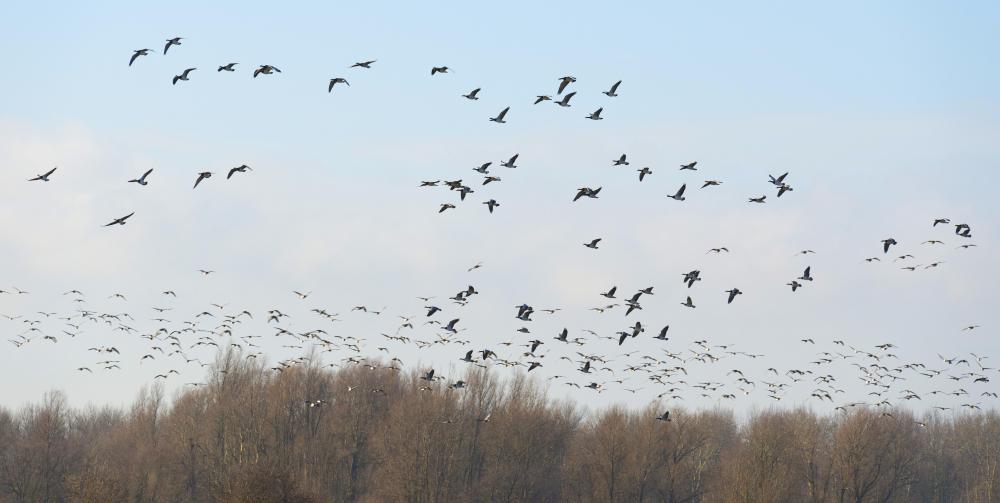At AllThingsNature, we're committed to delivering accurate, trustworthy information. Our expert-authored content is rigorously fact-checked and sourced from credible authorities. Discover how we uphold the highest standards in providing you with reliable knowledge.
What is a Barnacle Goose?
The barnacle goose, or Branta leucopsis, is an arctic species of goose that has its breeding grounds in Greenland, Norway, and Northern Russia. This species typically migrates to England, Ireland, and Scotland in the winter, or to Germany and the Netherlands in the case of Russian birds. Barnacle geese typically have a black neck and crown, a white face, gray flanks, a gray breast, and a black back. Both males and females of this species have the same markings, though males may be larger than females.
These geese take their name from the medieval belief that they developed from goose barnacles. Historians believe that this theory developed because medieval scientists did not understand bird migration patterns, and therefore sought an explanation for the sudden appearance of non-native bird species in some regions in the winter. Because barnacle geese were believed to develop from barnacles, medieval Europeans widely considered them a form of fish. The barnacle goose is therefore believed to have been a food staple during Lent, when meat could not be eaten.

The barnacle goose has a black crown and neck, with a white face resembling a mask. They also have black plumage on their backs, and black feet. The sides, breast, and flanks of the barnacle goose are gray. The barnacle goose also has a distinctive white rump.
Unlike some other bird species, there is generally no discernible difference in markings between the male and the female of the species. Males are typically more robust than females, weighing about 4.03 pounds (1.8 k), while the female usually weighs about 3.57 pounds (1.6 k). The male barnacle goose may grow to a length of 27 inches (68.5 cm), while the female barnacle goose typically reaches a maximum length of 23.5 inches (59.7 cm).

Barnacle geese are an arctic bird. Their breeding grounds are mostly located on the northern coast of Greenland. Breeding grounds have also been found in Svalbard, Norway, and the Russian islands of Vaygach Island and Novaya Zemlya. Barnacle geese typically form small nesting colonies on cliffs or among island crags. They often nest in proximity to Gyr falcons to protect themselves from arctic foxes. One female goose may lay four to six eggs per breeding season.
These birds migrate to England, Scotland, Ireland, Germany and the Netherlands, where they winter in the mud flats, estuaries, coastal marshes, and grasslands of these regions. They feed on seeds, roots, leaves, and stems.
While barnacle geese have been sighted in northeastern North America, they are not considered a North American bird. No barnacle geese breeding grounds have yet been found in North America, and the region is not believed to form a part of their migratory path. Some believe that barnacle geese are only sighted in North America when they escape from domestic captivity.
Frequently Asked Questions
What is a Barnacle Goose and where can it be found?
The Barnacle Goose is a medium-sized, migratory waterfowl belonging to the genus Branta. It is known for its distinctive black and white plumage and breeds in the Arctic regions of Greenland, Svalbard, and the Russian Arctic. In winter, it migrates to the British Isles, coastal Europe, and occasionally the northeastern United States.
Why is it called a Barnacle Goose?
The name "Barnacle Goose" was historically derived from a myth that the birds hatched from barnacles. This belief arose because people in medieval times never saw the geese nest and thought they spontaneously generated from goose barnacles found on driftwood. The scientific name, Branta leucopsis, means "white-faced" in Greek, referring to its appearance.
What does the Barnacle Goose eat?
Barnacle Geese are herbivores, primarily grazing on grasses, aquatic vegetation, and crops. During the breeding season in the Arctic, they also consume leaves, seeds, and small insects to supplement their diet. Their feeding habits shift slightly during migration and wintering, where they often feed on agricultural fields.
How does the Barnacle Goose breed and raise its young?
Barnacle Geese breed in colonies on high Arctic cliffs to avoid predators. They lay 3-5 eggs in a nest lined with down. Both parents share incubation duties for about 24-25 days. After hatching, goslings must make a perilous leap from the nest to the ground to follow their parents to feeding areas, a dramatic start to their lives.
Is the Barnacle Goose endangered?
As of my knowledge cutoff in 2023, the Barnacle Goose is not considered endangered. Its population has been increasing over the past few decades, thanks to conservation efforts and legal protection. The International Union for Conservation of Nature (IUCN) currently lists the Barnacle Goose as a species of "Least Concern."
What are the migration patterns of the Barnacle Goose?
Barnacle Geese undertake long migrations twice a year between their breeding and wintering grounds. They travel in large flocks and are known for their remarkable navigational abilities. During migration, they can cover up to 800 kilometers in a single day, often flying at high altitudes to take advantage of favorable wind conditions.
AS FEATURED ON:
AS FEATURED ON:












Discuss this Article
Post your comments